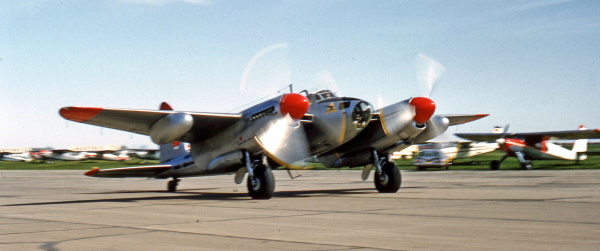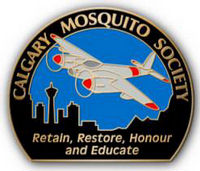
Click on any image for a slideshow!

We're Baaaack!
Here's What We've Been Up To In The Last 3 Months
With many restrictions lifted here in Alberta in mid-June, our gang reassembled to get back to work on the Mossie. Not surprisingly, we have had some record numbers of volunteers turn out. Welcome back to all! As of July 1, we could open the shop area to visitors, which hasn't been possible for the past 15 months. Come out and see what we are up to! There is Hurricane news and our hosts at the Bomber Command Museum have events and Lanc engine runs coming up soon.
Hurricane
With the easing of Covid restrictions we made contact with Historic Aviation Services to see about getting their guys to come down to Calgary to replace the fuel pump and nozzle with the unit we had overhauled by Vintage V-12s last year. Personal considerations and previously booked vacations have pushed things to late August before we can make the attempt. We have also spoken with the Hangar Museum to coordinate with them. We are budgeting three days to do the work and then get the airplane out on the ramp to attempt a start. Fingers crossed that this will do it and that we won't need to resort to 'Plan B' which involves getting Vintage V-12s staff up to Calgary for a full diagnosis of engine issues.
Mosquito
Jack McWilliam
As of the 1st of July, we were back in full operation at the Bomber Command Museum. With restrictions still in place through April, May and most of June, the start of the quarter was slow, but we have quickly accelerated back to a 'normal' pace.
Starting with the horizontal stabilizer, we have removed it from the strongback (R: Ya, I had to look it up. It means "A beam or girder which acts as a secondary support member to an existing structure.") and laid it back on the workbench again so as to allow us access to the trailing edge.

The horizontal stabilizer as it was mounted on the ‘strongback’, and now flat on the bench to allow Cam B. and Michael H. access to its trailing edge. The first job is to scrape away all of the fibreglass, paint and primer and then reinstall all of the fiddly bits attached to the rear spar.
Cam B. and Michael H. finished removing old fibreglass and paint from the rear spar area, completing the cleaning on the stab. Cam has started installing the trailing edge ribs which, once completed, will allow us to complete skinning the upper and lower surfaces.
Gary T. and Dick S. continue work on the flaps with Gary having completed the first of the four flap sections. Dick is just in the process of fitting the final skin to complete the second flap. As the flaps will not be mated to the wing for some time, Roger D. has built two crates to house all of the flaps which will then be placed in offsite storage until the wing is further along.

Flap restoration by Gary T. with crate by Roger D. We have arranged interim storage to get the larger completed components out of our work space until needed for airframe assembly.
In between their wood projects, Gary and Dick are also experimenting with ways of forming new lenses for the wing tip navigation lights.

The mold for the wing tip navigation light lens, attempt #1. (May yet need a little ironing or something to take out the wrinkles…)
Before we tackle some of the structural repairs on the wing, we need to redesign the support jig in which it has been stored since we moved it to Nanton in 2012. Andy W. has taken the lead on this project and has just ordered additional steel beams and struts for the redesigned structure.

Some of Andy’s redesign work for the wing stand which needs to be modified to allow us to do some structural repairs. The stand has served well to hold the wing for the last 10 years, but before we remove wing skins it has to be redesigned to hold the spars and ribs in rigid fashion to ensure structural integrity.
Once these are in hand, we will move the wing into a vertical and fixed position before we start upper wing skin removal and replacement. Stripped of its fabric and left outdoors when at CFB Cold Lake in 1990, we estimate that 25% of the upper skins on the starboard side of the wing are rotten, to the point that you can pull wood off with your little finger.
The upper center section of the wing has a lot of mechanical components which need to be removed before we can look at structural issues. Brian C., Steve S. and Mathew S. have been working on this area.

Roger D. demonstrates how easy it is to remove wood from some areas of the upper wing skin. Time and moisture have done their thing to produce significant rot in some areas of the wing.
Davie D., Jerry M. and Andrew S. are attacking the leading edge to remove the mangled mess of bent metal, cables, controls and rotten wood. We need the leading edge cleared of all mechanical bits before we look at repositioning and supporting the wing in the redesigned jig.

Because the wing is currently mounted with the leading edge to the floor, removing any mechanical components from the front spar can be a significant challenge as Steve S. can attest.
A number of individuals (Robyn M., Chris D., Richard de B.) have been 'enjoying' the delightful task of physically removing multiple layers of paint, grease, oil and primer from the underside of the wing, in the fuel tank bays and from the wheel wells. Colette P. has focused on the wheel wells which may be the nastiest areas of the wing with an overabundance of +75 year old oil, dirt and paint. One must remember that this aircraft didn't get to spend its life in heated hangars with polished floors and LED lighting.

Society Treasurer Colette P. tackles the job of mechanically paint stripping the port wheel well -one tiny chip at a time. If one surrenders to the task, it can be a rather ‘Zen’ like experience. One of the rewards of the work is uncovering penciled notes from 1946 and manufacturers stamps on the wood telling us it was made in 1943 and meets standard “BS 6V3”.
Michael H. and Roger D. are currently removing the mechanical parts from the trailing edge of the wing. Recognizing the complexity of all of the systems that run along the leading and trailing edge spars, Davie D. has designed and built 'holding boards' for all of the parts being removed so that we don't lose track and find ourselves a couple of years from now asking, 'What went where?'

Here Davie D. is working on the front spar mock up that he designed and built, so that we can keep track of all the mechanical parts as we remove them from the wing. Virtually every system on the airplane intersects at this point: Fuel, hydraulic, control lines, pneumatic and electric. Do it now, or rue the consequences down the line!
We are finding that a lot of the glue holding the wing together has crystallized and gone 'time expired' so, as with the horizontal stabilizer, we will clean each joint and re-glue them as a necessary part of the rebuild process.
Back on the fuselage, Don H. continues to organize and reinstall the mechanical components on the side panels that fit under the wing of the airplane. These panels house many parts that are important for connecting the mechanical systems, chiefly fuel and hydraulic, between the cockpit and wing.

The fuselage side panels which fit just under the wing are being carefully reconstructed by Don H. As they were less than complete when we started, Don checked reference photos on two other B.35 Mosquitoes only to discover that they are quite different from each other and from ours. The fun continues.
Storage of the larger restored components such as the horizontal stabilizer and flaps is becoming an issue so Richard de B. and Bomber Command Museum Curator, Karl Kjarsgaard have come up with a storage option that keeps these parts secure but out of our work space area until they are needed for assembly of the airframe.
Our hosts at the Bomber Command Museum have scheduled some event days with Lancaster engine runs starting on July 24. To accommodate this we will need to move the strongback and address some 'work space creep' to allow visitor access to areas of the shop that have been taken over by tables, tools and various projects.
Events and Miscellaneous
With Covid restrictions being moved to Phase 2, we were able to return to our Saturday work days at the Bomber Command Museum in mid-June and it is obvious by the volunteer turn out numbers that people are anxious to get back at it. With the further lifting of restriction on July 1, we are able to open the shop doors and welcome museum visitors back into our work space and share with them the progress we have made in the past 15 months.
Back in May, CBC Television caught wind of our 'at home' restoration projects as a way for us to maintain momentum on the project while under Covid restrictions, and they asked to do a short news piece. Our thanks to Dave Gilson of CBC for his interest. Dave is a true aviation, history and WWII buff, and it was great to work with a knowledgeable and enthusiastic member of the media. CBC aired the story on May 8, with a text version of it posted on their website at: Mosquito Restoration Calgary Bomber Museum
The Bomber Command Museum has scheduled some Open House events for the season, including Lancaster engine runs, with the first going on July 24. Additional event days are scheduled for August 2 and 28. These Saturdays are great opportunities for us to chat with and host hundreds of visitors, sell some merchandise and fulfill our broader mandate to 'Honour and Educate', though the restoration work tends to take a serious hit on these days. Details at: Bomber Command Museum
We were sorry to have to bid farewell to long time Saturday restoration volunteer and inveterate cookie supplier, Peter VanderKloot who is moving to Ontario to be closer to family. Before heading east, Peter gifted us a large collection of original glass plate negatives that were the product of the aerial photo mapping work done by our Mosquito with Spartan Air Services and by Kenting and others through the 1950s.

A sample of the 9" square glass plate negatives donated to us by Peter VanderKloot. Though shot on conventional film the negatives were then backed with glass to make them 100% flat and square; a necessity in order to produce accurate maps from them.
These 9" square negatives were then used to produce the first complete and comprehensive map base for all of Canada. Board member Don H. has been in touch with the National Air Photo Library in Ottawa which has expressed an interest in archiving some of this collection and we are happy to share our bounty with them. We are open to ideas on what best to do with the balance of them.

Richard de Boer, President
July 12, 2021

Website - Calgary Mosquito Aircraft Society


